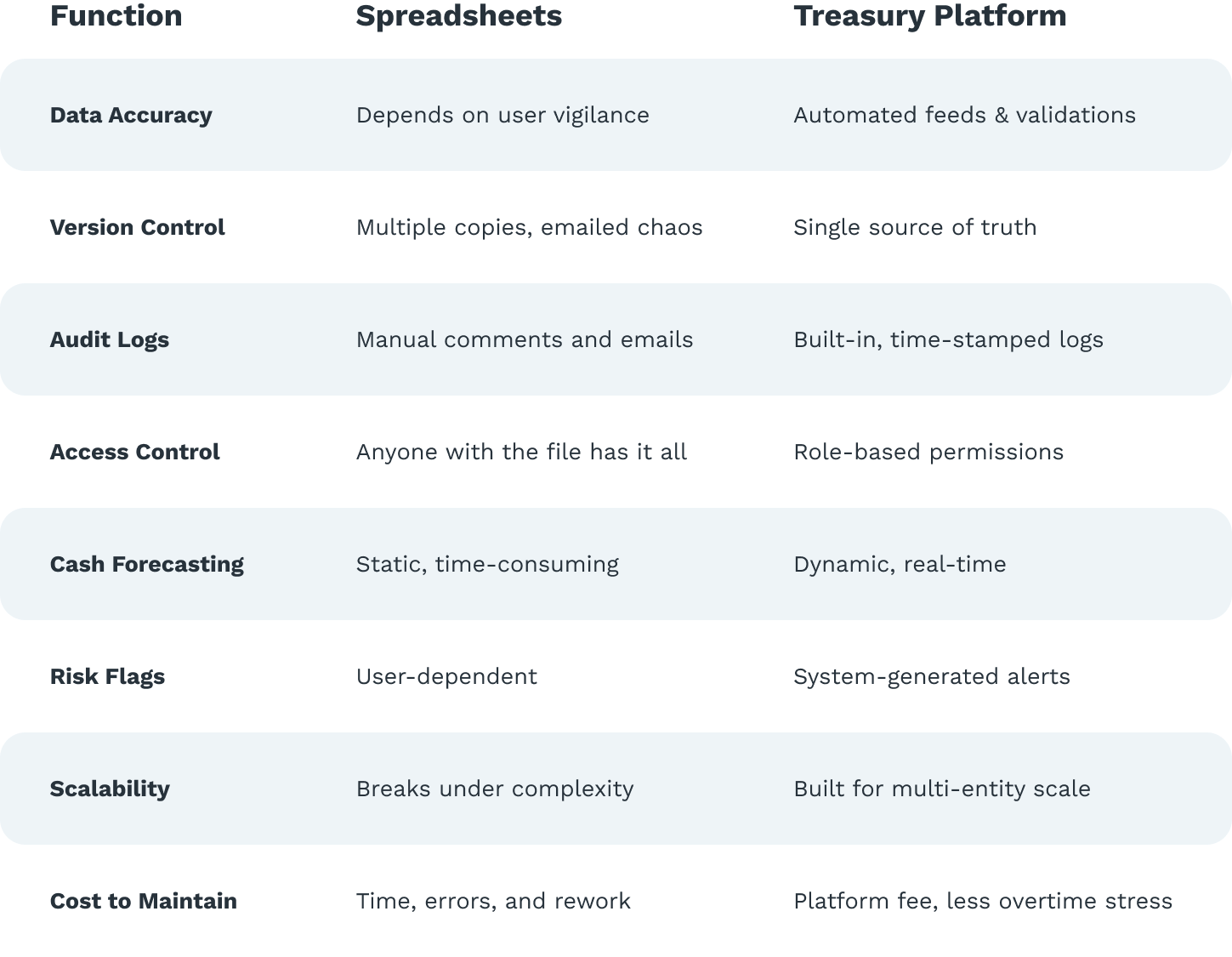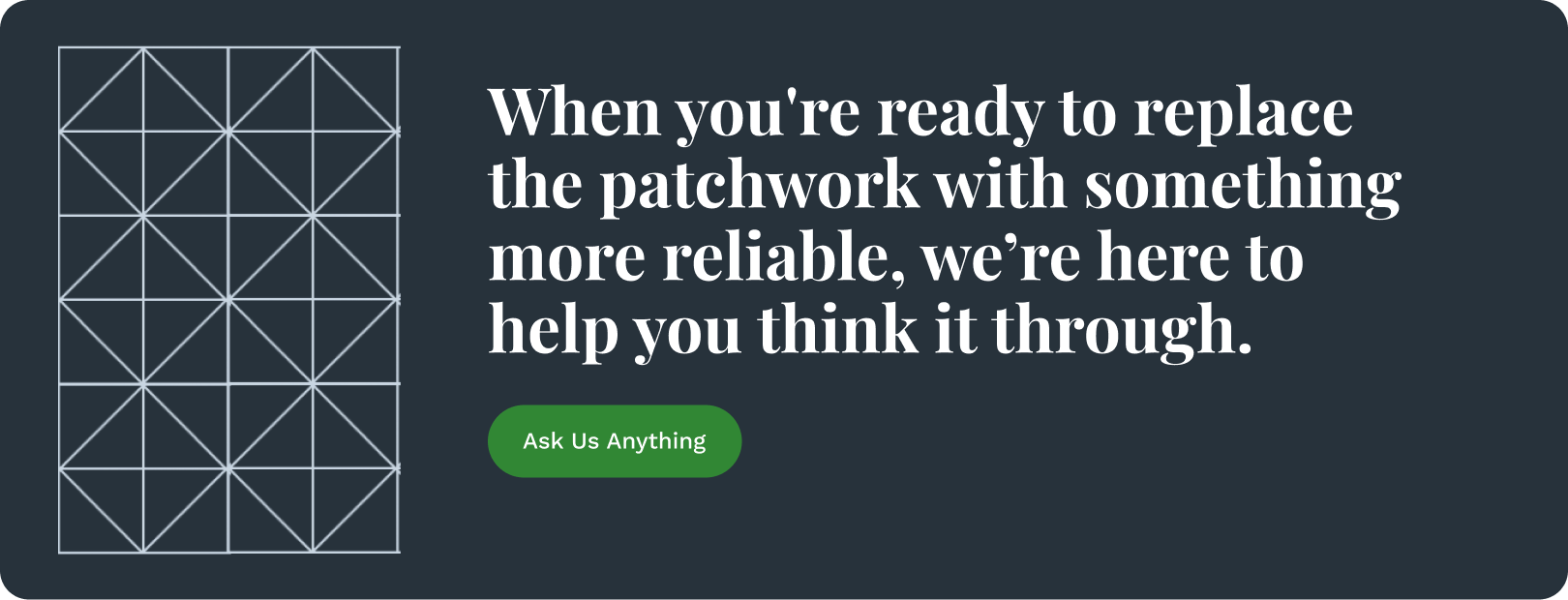Matchup: Spreadsheets vs Treasury Platforms—Which Can You Rely on for Compliance Data?
Compliance is the broccoli of finance. You know it’s good for you, but it’s not exactly a Friday night craving. And managing it with spreadsheets? That’s like trying to run a commercial kitchen with a toaster oven and a dream.
Excel is fast, flexible, and feels like home. But when you're juggling cash visibility, audit trails, and version control—while also trying not to break something important—spreadsheets start to groan under the pressure.
Let’s break down where spreadsheets still pull their weight, where they buckle, and whether it’s time to swap in a treasury platform that actually scales.
Short on time? Here’s what matters.
Spreadsheets can’t keep up with cash visibility and compliance once things start to scale.
- Errors, delays, and version control issues are quiet risks until they become loud ones.
- Treasury platforms offer built-in audit trails, real-time data, and better control.
- You don’t have to switch everything overnight—but waiting until something breaks isn’t a great strategy.
- If compliance touches your cash, it’s worth exploring a better setup now.
Skip to the bottom for 4 practical steps to start switching off spreadsheets.
Spreadsheets: The DIY King of Compliance (Until It’s Not)
Let’s give Excel credit. It’s the tool that got a million teams through regulatory reporting, internal audits, and “please don’t let this break” moments. For power users, it’s practically a coding language.
But here's what compliance data in spreadsheets actually looks like:
- Ten tabs. All named slightly differently. Only three are current.
- A complicated formula that used to work until Susan sorted Column D.
- Notes in the margins. Color-coded cells. A warning that says “DO NOT DELETE.”
Does that hit a little close to home? Spreadsheets work—until you start needing them to:
- Automatically flag missing or expired compliance documents
- Update forecasts when a new vendor or regulation is added
- Generate audit-ready logs with zero human effort
- Protect against formula errors introduced at 6:45 PM on a Friday
You know what happens when a file gets emailed back and forth 12 times? Risk. The sneaky, silent kind.
What a Treasury Platform Does That Excel Never Will
A treasury platform isn’t just a fancier spreadsheet. It's an infrastructure layer for cash visibility, compliance oversight, and risk mitigation.
When you need to answer questions like:
- “How much cash do we really have access to if X goes sideways?”
- “Which bank accounts are out of compliance with our internal policy?”
- “What’s the audit trail for that flagged transaction?”
A treasury platform gives you one-click answers. Not 17 tabs and a prayer.
Here's what else it brings to the table:
- No More Chasing Data: You can’t move fast if you're busy stitching together numbers from 10 places just to get a baseline. A treasury platform gives you the full picture without the scavenger hunt—real-time, audit-ready, and already where it should be.
- Real-Time Visibility: Forget digging through files or hitting Ctrl+F on version 9.2. Get live views of balances, reconciliations, compliance, and variances—no assembly required.
- Built-In Audit Trails: Systems track every action, every approval, every “who touched what when.” Your auditors will be thrilled. Your team won’t lose sleep.
- Risk Detection: A spreadsheet doesn’t whisper “Hey, this account hasn’t reconciled in 60 days.” A platform does. Proactive beats reactive every time.
- Permissions and Controls: “Oops, someone sorted the sheet wrong” becomes “That person didn’t have access to that field.” Controlled inputs = fewer headaches.
- Forecasting Without the Admin Overhead: Pulling data from banks, entities, and systems shouldn’t take all day. Forecasts update automatically—no more copy-pasting, formatting, or double-checking formulas.
Spreadsheet vs Treasury Platform: A Side-by-Side Breakdown
Let’s stack ‘em up. Here’s how each handles the real world of compliance-driven cash management:

You can make a spreadsheet do almost anything... eventually. But that “eventually” might cost you missed risk, delayed reporting, or failed audits.
Why This Matters More Than You Think
Compliance isn’t about checking boxes. It’s about protecting your cash.
Late reporting? That’s a funding delay.
Missing a flagged item? That’s regulatory risk.
No backup audit trail? That’s panic during a board meeting.
The more visibility you have into your cash—and the compliance tied to it—the more confidently your finance team can act. Treasury platforms aren’t just a nice-to-have. They're a seatbelt for your company’s most liquid asset.
When Spreadsheets Still Make Sense
Not everything needs a platform.
- If your org is small and your compliance needs are low-stakes
- If you have just one bank, one entity, and no real-time reporting needs
- If your team is spreadsheet-native and the process works without cracks
Then sure, spreadsheets might be enough... for now.
Just don’t wait until you have to change. Because when compliance breaks, it rarely does it quietly.
4 Steps Toward a Smarter Cash and Compliance Setup
If you're starting to question whether spreadsheets are still cutting it, check out these five steps on how to move forward without wasting time, money, or patience.
1. Identify the bottlenecks
Start by looking at how your spreadsheet-based process actually plays out day to day. You're trying to spot where things slow down, get messy, or quietly introduce risk. It usually shows up in things like:
- Multiple versions of the same file
- Manual data entry from banks or teams
- Deadlines missed because no one knew the latest number
These issues are usually easy to spot once you start paying attention. Flag the ones that affect timelines, accuracy, or team coordination most.
2. Define what better looks like
Once the friction points are visible, it helps to define what a better setup would look like—for your team, your workload, and your goals. That might include:
- Real-time visibility into cash across accounts
- A more centralized way to track compliance requirements
- Fewer manual steps or handoffs between people
- A system that holds up, even when someone sorts the data wrong
This list doesn’t have to be long or formal. It’s just a way to focus on what actually matters as you start exploring options.
3. Research tools that fit
Explore treasury and cash platforms that are designed for companies with similar needs and scale. Focus less on the sales pitch and more on what aligns with the challenges you’re trying to solve.
What’s worth paying attention to:
- Features that address the specific pain points you’ve already identified
- Transparent pricing and terms—no surprises buried in the fine print
- Clear implementation timelines, not vague estimates
- A track record of working with teams similar in size, structure, or industry
As you go, create a shortlist. Save what stands out. You don’t need to decide yet—just start building a sense of what might be a fit.
4. Talk to a couple of vendors
Once you’ve found a few platforms that seem like a fit, set up a quick conversation. Skip the surface-level demos and get into what actually matters to your team.
Helpful things to ask:
- What does rollout typically look like for a team our size?
- Can we start small—with one workflow—before scaling up?
- How are other finance teams using this day to day?
This isn’t about making a decision on the spot. It’s about seeing whether the platform could actually make things easier.
If You've Learned One Thing From This Article…
It’s that spreadsheets aren’t the enemy—but they’re not a long-term strategy, either.
If your cash process depends on someone remembering which file to open or how a formula was built six months ago, you’re working without a net. And when compliance is part of the equation, that risk grows quietly until it doesn’t.
You don’t have to overhaul everything tomorrow. But it’s worth asking: What’s one part of your cash or compliance workflow that could run smoother, with fewer hands, and less rework?
That’s where you start.


